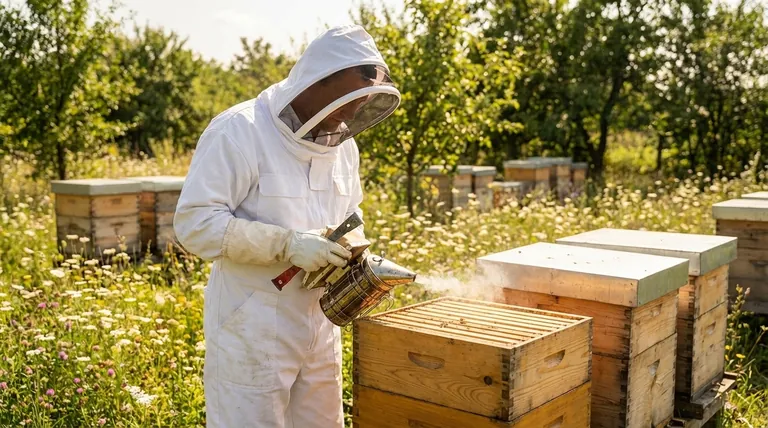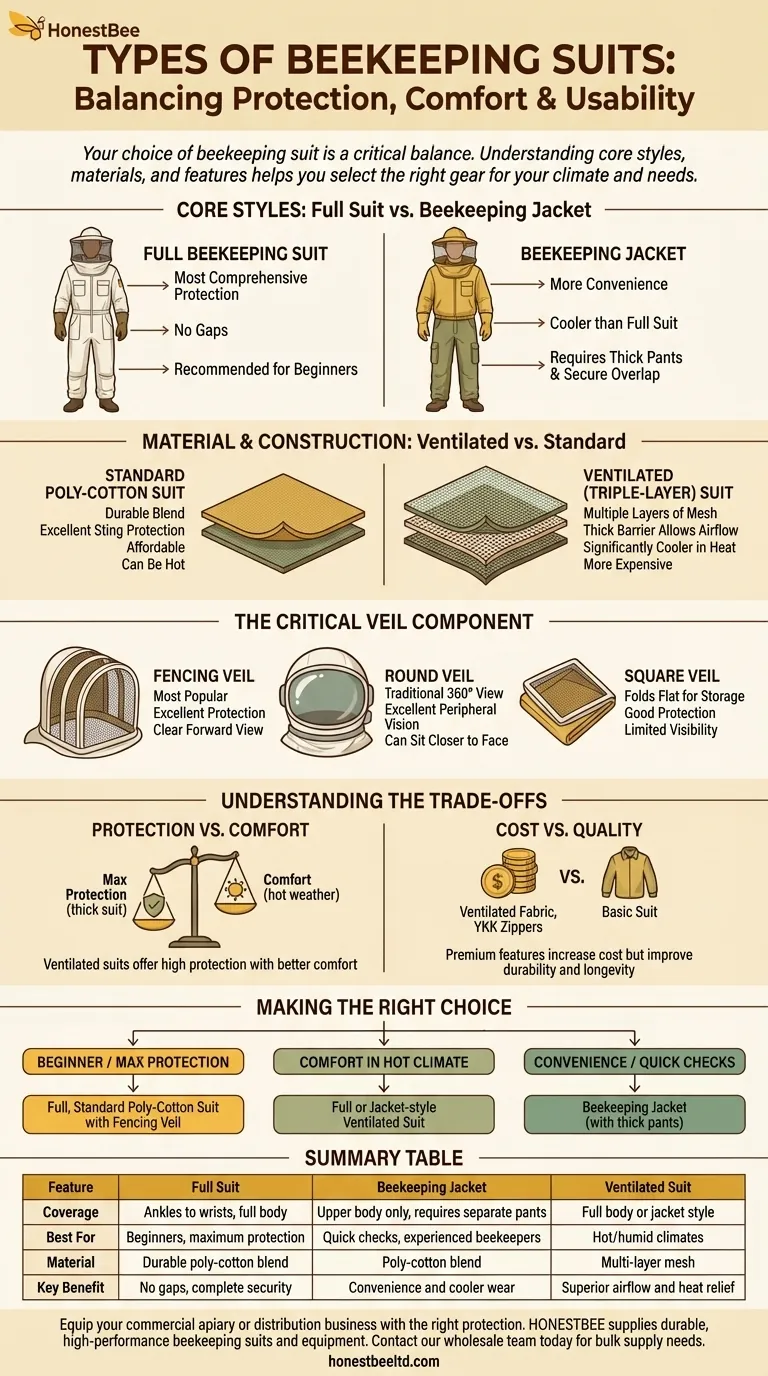The primary types of beekeeping suits are categorized by their coverage and material. You can choose between a full-body suit or a simpler jacket, with the main material options being a standard polyester-cotton blend for durability or a multi-layer ventilated mesh for superior airflow in warmer climates.
Your choice of beekeeping suit is a critical balance between protection, comfort, and usability. Understanding the core styles, materials, and key features will allow you to select gear that matches your climate and personal comfort level with bees.

Core Styles: Full Suit vs. Beekeeping Jacket
The first decision you will make is how much coverage you need. This choice depends on your confidence level and the temperament of your bees.
The Full Beekeeping Suit
A full suit is a one-piece garment that covers you from your ankles to your wrists and includes an integrated hood and veil.
This style offers the most comprehensive protection, ensuring there are no gaps between your top and bottom for bees to enter. It is the recommended choice for beginners.
The Beekeeping Jacket
A beekeeping jacket is an upper-body-only garment that includes the essential integrated hood and veil.
This option provides more convenience and is cooler than a full suit. However, it must be paired with thick pants and you must ensure a secure overlap at the waist to prevent bee entry.
Material and Construction: Ventilated vs. Standard
The material of your suit directly impacts your comfort during hive inspections, especially during hot weather.
Standard Poly-Cotton Suits
The most common and affordable suits are made from a durable blend of polyester and cotton.
This thick material provides excellent sting protection. Modern versions often include useful features like large pockets for tools and elastic or zippered cuffs.
Ventilated (Triple-Layer) Suits
Ventilated suits are constructed from multiple layers of mesh fabric.
This design creates a thick barrier that is too deep for a bee's stinger to penetrate, while simultaneously allowing for maximum airflow. This makes them significantly cooler and more comfortable in hot and humid climates.
The Critical Veil Component
The veil is arguably the most important part of your protective gear. Its design affects your visibility, comfort, and sense of security.
The Fencing Veil
This is the most popular modern style. It features a structured shape, often supported by integrated wiring, that holds the mesh screen completely away from your face. This provides excellent protection and a clear forward view.
The Round Veil
The traditional round veil offers a 360-degree field of view, resembling an astronaut's helmet. While it provides excellent peripheral vision, the mesh can sometimes sit closer to your face than a fencing veil.
The Square Veil
A square veil is a less common style that can be folded flat for easy storage. It offers good protection but can sometimes have more limited visibility compared to the other two types.
Understanding the Trade-offs
Choosing the right suit involves balancing competing factors. Being aware of these will help you make a more informed decision.
Protection vs. Comfort
There is a direct trade-off between the level of protection and your physical comfort. A thick, full-body suit offers maximum security but can be very hot.
A ventilated suit is a direct response to this challenge, offering high protection with significantly better comfort in the heat.
Cost vs. Quality
Premium features like ventilated fabric, heavy-duty YKK zippers, and reinforced pockets increase the cost of a suit.
While a basic poly-cotton suit is more affordable, investing in a higher-quality suit often pays off in durability, longevity, and a much more comfortable beekeeping experience. Look for overlapping zippers and tight-fitting elastic or velcro closures, which are hallmarks of a well-designed, sting-proof suit.
Making the Right Choice for Your Needs
Your ideal suit depends entirely on your specific goals and environment.
- If your primary focus is maximum protection and you are a beginner: Choose a full, standard poly-cotton suit with a fencing veil to ensure no gaps and build your confidence.
- If your primary focus is comfort in a hot climate: A full or jacket-style ventilated suit is the best investment you can make for enjoyable summer inspections.
- If your primary focus is convenience for quick hive checks: A beekeeping jacket offers a great balance of protection and ease of use, provided you pair it with thick, light-colored pants.
Choosing the right suit is the first step toward confident, safe, and enjoyable beekeeping.
Summary Table:
| Feature | Full Suit | Beekeeping Jacket | Ventilated Suit |
|---|---|---|---|
| Coverage | Ankles to wrists, full body | Upper body only, requires separate pants | Full body or jacket style |
| Best For | Beginners, maximum protection | Quick checks, experienced beekeepers | Hot/humid climates |
| Material | Durable poly-cotton blend | Poly-cotton blend | Multi-layer mesh |
| Key Benefit | No gaps, complete security | Convenience and cooler wear | Superior airflow and heat relief |
Equip your commercial apiary or distribution business with the right protection. HONESTBEE supplies durable, high-performance beekeeping suits and equipment designed for the demands of professional beekeepers. From standard poly-cotton suits to advanced ventilated models, we provide the gear that keeps your operations safe, comfortable, and efficient. Contact our wholesale team today to discuss your bulk supply needs and get a quote.
Visual Guide

Related Products
- Cotton Beekeeping Suit and Round Hat with Veil Bee Keeper Protective Gear
- White Beekeeping Protective Suit and Hat with Fencing Veil for Beekeepers
- Heavy Duty Cowboy Beekeeper Hat with Visibility Veil Outdoor Professional Beekeeping Protective Gear
- Beekeeper Cowboy Hat and Veil for Beekeeping
- Professional Beekeeping Suit for Kids and Girls Childrens Bee Keeper Suit
People Also Ask
- Why is white the predominant color in bee suit designs? | Key to Hive Calm & Beekeeper Safety
- Do beekeeping suits completely prevent stings? Maximize Your Apiary Safety with the Right Gear
- What factors should be considered when choosing a beekeeping suit? Balance Safety, Comfort & Performance
- How should a beekeeping suit be hung to maintain its shape? Protect Your Investment with Proper Storage
- What are the benefits of a fully ventilated beekeeping suit? Stay Cool and Protected in Hot Climates



















